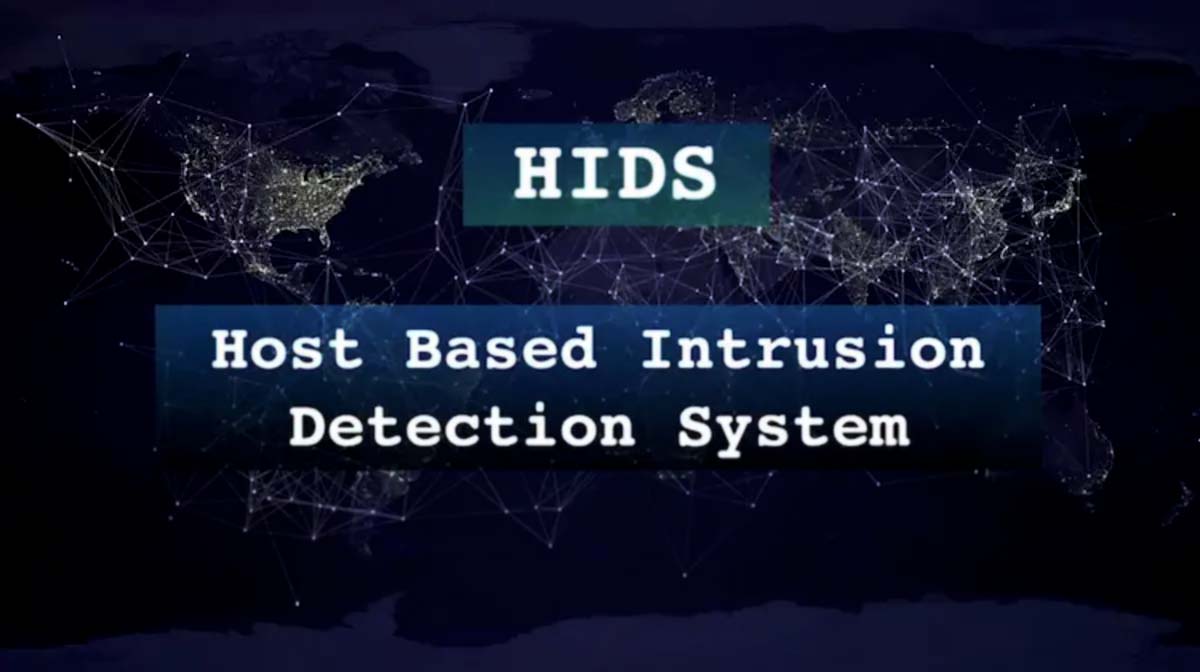Home>Home Security and Surveillance>What Type Of Attacks Can Network-Based Intrusion Detection Systems (IDSS) Detect


Home Security and Surveillance
What Type Of Attacks Can Network-Based Intrusion Detection Systems (IDSS) Detect
Modified: March 6, 2024
Learn how network-based intrusion detection systems (IDSS) can detect various types of attacks in home security and surveillance. Ensure your network is protected with an effective IDSS solution.
(Many of the links in this article redirect to a specific reviewed product. Your purchase of these products through affiliate links helps to generate commission for Storables.com, at no extra cost. Learn more)
Introduction
In today’s digital age, the security of our homes and personal belongings is of paramount importance. As technology continues to advance, so do the methods used by criminals to infiltrate our homes and compromise our safety. This is where home security and surveillance systems play a crucial role in protecting our homes and loved ones.
One of the key components of a comprehensive home security system is a network-based intrusion detection system (IDSS). This powerful technology is designed to monitor network traffic and identify any suspicious or malicious activity that may indicate a potential threat to the security of our homes. By detecting and alerting us to these threats, network-based IDSS acts as a vital line of defense against cyber attacks and intrusions.
In this article, we will explore the importance of network-based intrusion detection systems in home security and surveillance. We will also delve into the various types of attacks that these systems can detect, providing you with a deeper understanding of how they work and the benefits they offer.
Key Takeaways:
- Network-based Intrusion Detection Systems (IDSS) are like digital security guards for our homes, protecting against cyber attacks like hackers trying to break in. They watch for unusual activity and help keep our networks safe.
- IDSS can detect sneaky cyber attacks like tricking our computers into going to fake websites or trying to guess our passwords. They act like superheroes, keeping our personal information safe from bad guys.
What is a Network-Based Intrusion Detection System (IDSS)
A network-based intrusion detection system (IDSS) is a security solution that monitors and analyzes the network traffic flowing through a home or business network. Its primary purpose is to identify and alert users to any suspicious or malicious activity that may be indicative of an intrusion or cyber attack.
Unlike traditional firewalls that focus on preventing unauthorized access, a network-based IDSS works by analyzing network packets in real-time. It examines the contents of these packets to look for patterns, signatures, and anomalies that may indicate potential security threats. This real-time analysis allows the IDSS to quickly identify and respond to emerging attacks, minimizing the damage caused by intrusions.
Network-based IDSS can operate in two modes: passive mode and active mode. In passive mode, the IDSS monitors network traffic without taking any direct action. It collects data, analyzes it, and generates alerts to notify users of potential threats. In active mode, the IDSS goes a step further by actively responding to detected threats. It may block suspicious traffic, terminate connections, or initiate countermeasures to neutralize the attack.
One of the key advantages of network-based IDSS is its ability to operate at the network level. This means that it can detect attacks targeting various network protocols and services, including HTTP, FTP, SMTP, and DNS. By analyzing network traffic at this level, the IDSS can identify a wide range of attacks across different layers of the network stack.
Furthermore, network-based IDSS can provide valuable insights into network vulnerabilities and security weaknesses. By monitoring traffic patterns and analyzing attack signatures, it can help security administrators identify potential vulnerabilities and take proactive measures to strengthen network defenses.
Overall, a network-based intrusion detection system is a vital component of a comprehensive home security and surveillance setup. Its ability to detect and respond to malicious activity in real-time enhances the overall security posture of a network, ensuring the safety of our homes and the privacy of our personal data.
Importance of Network-Based Intrusion Detection Systems
As the complexity and frequency of cyber attacks continue to rise, it has become imperative to incorporate robust security measures to protect our homes and personal data. Network-based intrusion detection systems (IDSS) play a crucial role in home security and surveillance by providing real-time monitoring and protection against potential threats. Here are some key reasons why network-based IDSS are important:
1. Early Threat Detection: Network-based IDSS constantly monitors network traffic and detects any suspicious activity or anomalies that may indicate a potential attack. By identifying threats at an early stage, IDSS can help prevent breaches and minimize the damage caused by cyber attacks.
2. Enhanced Incident Response: When a network-based IDSS detects a potential security breach, it generates alerts and notifications for an immediate response. This enables security administrators to take proactive measures, such as terminating connections, blocking traffic, or implementing countermeasures to neutralize the attack and prevent further damage.
3. Protection Against Various Attack Types: Network-based IDSS is designed to detect a wide range of attack types, including but not limited to denial of service (DoS) attacks, distributed denial of service (DDoS) attacks, port scanning attacks, man-in-the-middle (MitM) attacks, SQL injection attacks, cross-site scripting (XSS) attacks, and session hijacking attacks. By identifying these threats, the IDSS ensures comprehensive defense against multiple attack vectors.
4. Compliance with Regulatory Standards: Many industries and organizations are required to adhere to strict security regulations and standards. Network-based IDSS helps meet these requirements by providing the necessary monitoring and detection capabilities. It assists in maintaining compliance and avoiding penalties or legal consequences associated with inadequate security measures.
5. Protection of Personal and Sensitive Information: In today’s digital world, our homes contain valuable personal and sensitive information that needs to be safeguarded. Network-based IDSS helps protect this data by monitoring network traffic and identifying any unauthorized attempts to access or compromise confidential information. This ensures the privacy and integrity of our personal data.
6. Safeguarding IoT Devices: With the increasing popularity of smart home devices, securing the Internet of Things (IoT) has become critical. Network-based IDSS can detect any suspicious activity targeting IoT devices connected to the network, preventing unauthorized access and potential compromise of these devices.
7. Scalability and Flexibility: Network-based IDSS can be scaled up or down based on the size and complexity of the network. Whether it’s a small household network or a large enterprise network, IDSS can be customized to meet the specific security requirements, providing flexibility and adaptability for different environments.
By implementing a network-based intrusion detection system, homeowners can gain peace of mind knowing that their networks and devices are protected from potential threats. These systems act as a proactive line of defense, enhancing the overall security and resilience of home security and surveillance systems.
Types of Attacks Detected by Network-Based IDSS
Network-based intrusion detection systems (IDSS) are designed to detect and protect against a wide range of cyber attacks. These attacks can target various aspects of network security, compromising the integrity, confidentiality, and availability of data. Let’s explore some of the common types of attacks that network-based IDSS can detect:
- Denial of Service (DoS) Attacks: DoS attacks aim to flood a network or system with an overwhelming amount of traffic or requests, rendering it inaccessible to legitimate users. Network-based IDSS can identify and mitigate DoS attacks by identifying abnormal traffic patterns and implementing countermeasures to maintain network availability.
- Distributed Denial of Service (DDoS) Attacks: DDoS attacks involve multiple compromised devices flooding a network with malicious traffic, overwhelming network resources. Network-based IDSS detects the sudden surge in traffic from multiple sources and differentiates it from legitimate traffic, allowing for prompt mitigation of DDoS attacks.
- Port Scanning Attacks: Port scanning attacks involve an attacker scanning a network to identify open ports on target devices. Network-based IDSS monitors network traffic for port scanning patterns, detecting and alerting administrators to potential reconnaissance attempts or unauthorized access attempts.
- Man-in-the-Middle (MitM) Attacks: In MitM attacks, an attacker intercepts and alters communications between two parties, often stealing sensitive information or injecting malicious content. Network-based IDSS can detect suspicious changes in communication patterns or the presence of unauthorized devices attempting to act as intermediaries.
- SQL Injection Attacks: SQL injection attacks target web applications by exploiting vulnerabilities in the underlying SQL database. Network-based IDSS can identify suspicious SQL query patterns or malicious input that could indicate an attempted SQL injection attack.
- Cross-site Scripting (XSS) Attacks: XSS attacks inject malicious scripts into web pages viewed by users, potentially allowing the attacker to steal sensitive information or hijack user accounts. Network-based IDSS examines web traffic and identifies patterns indicative of XSS attacks, ensuring the integrity and security of web applications.
- Buffer Overflow Attacks: Buffer overflow attacks exploit vulnerabilities in software by flooding a buffer with more data than it can hold, potentially leading to arbitrary code execution or system crashes. Network-based IDSS can detect unusual traffic patterns and behavior indicative of buffer overflow attacks.
- Session Hijacking Attacks: Session hijacking attacks aim to steal session tokens or cookies to gain unauthorized access to a user’s session. Network-based IDSS identifies anomalies in session behavior or unexpected changes in session information, helping prevent session hijacking attempts.
- Brute Force Attacks: Brute force attacks involve systematically attempting various combinations of passwords or encryption keys until the correct one is found. Network-based IDSS can detect multiple failed login attempts or unusual patterns of login activity, alerting administrators to potential brute force attacks.
- DNS Spoofing Attacks:DNS spoofing attacks manipulate the DNS resolution process, redirecting users to malicious websites or hijacking their communications. By analyzing DNS traffic, network-based IDSS can detect inconsistencies or anomalies in DNS responses, mitigating DNS spoofing attacks.
By alerting administrators to these various types of attacks, network-based IDSS plays a critical role in identifying and mitigating potential threats to network security. It helps maintain the integrity, availability, and confidentiality of data, ensuring a safer and more secure network environment.
Denial of Service (DoS) Attacks
Denial of Service (DoS) attacks are one of the most common and disruptive types of cyber attacks. The primary objective of a DoS attack is to render a network, system, or service unavailable to legitimate users by overwhelming the target with an excessive amount of traffic or requests.
Network-based intrusion detection systems (IDSS) play a crucial role in detecting and mitigating DoS attacks. They monitor network traffic and analyze patterns to identify abnormal behavior indicative of a potential attack. Here’s how IDSS can detect and counteract DoS attacks:
1. Traffic Volume Monitoring: IDSS constantly monitors network traffic, keeping track of the normal volume of incoming network requests. When a sudden surge in traffic occurs, it can be an indicator of a DoS attack. IDSS algorithms detect the abnormal traffic pattern and generate an alert to notify administrators.
2. Rate Limiting: IDSS can implement rate limiting techniques to mitigate the impact of DoS attacks. By limiting the rate at which certain types of requests or connections are accepted, it can prevent network resources from being overwhelmed. Rate limiting can be based on factors such as source IP address, destination port, or protocol.
3. Anomaly Detection: Anomaly detection is a key feature of IDSS that helps detect and mitigate DoS attacks. It involves the comparison of real-time traffic patterns with a baseline of normal behavior. If the traffic deviates significantly from the expected patterns, IDSS generates an alert, indicating a possible DoS attack.
4. Blacklisting: IDSS can maintain a blacklist of IP addresses known to be associated with malicious activities or participating in DoS attacks. When traffic originates from these blacklisted IP addresses, the IDSS can automatically block or redirect it, protecting the network from further impact.
5. Behavior-based Analysis: IDSS can analyze the behavior of network traffic to identify anomalies that may indicate a DoS attack. By examining factors such as packet size, packet rate, or protocol violations, IDSS can distinguish between legitimate and malicious traffic.
6. Protocol-specific Detection: Some IDSS solutions are equipped with the capability to detect DoS attacks specific to certain protocols, such as HTTP, DNS, or SIP. For example, an IDSS may analyze HTTP traffic for patterns like an excessive number of POST requests or a high number of failed authentication attempts.
By detecting and mitigating DoS attacks, network-based IDSS helps ensure that critical network resources remain accessible and available to legitimate users. It minimizes the impact of DoS attacks on the network’s performance and prevents disruption to essential services and operations.
It is important for organizations to implement a network-based IDSS as part of their overall security strategy to protect against the detrimental effects of DoS attacks. By doing so, they can enhance the resilience and availability of their network infrastructure.
Distributed Denial of Service (DDoS) Attacks
Distributed Denial of Service (DDoS) attacks pose a significant threat to network security by overwhelming a target with an excessive amount of traffic or requests. Unlike traditional Denial of Service (DoS) attacks, DDoS attacks employ a network of multiple compromised devices, known as a botnet, to carry out the attack. This distributed nature makes DDoS attacks even more challenging to detect and mitigate.
Network-based intrusion detection systems (IDSS) play a critical role in identifying and mitigating DDoS attacks. By constantly monitoring network traffic and analyzing patterns, IDSS can detect and counteract these attacks. Here’s how IDSS detects and mitigates DDoS attacks:
1. Traffic Pattern Analysis: IDSS analyzes network traffic patterns to identify sudden and abnormal increases in incoming traffic. DDoS attacks typically lead to a significant spike in network traffic, exceeding normal levels. IDSS algorithms detect these patterns and generate alerts, indicating a possible DDoS attack.
2. Anomaly Detection: Anomaly detection is a key feature of IDSS that helps detect and mitigate DDoS attacks. By establishing a baseline of normal behavior for network traffic, IDSS can compare real-time traffic patterns against this baseline. Any significant deviation from the expected behavior is flagged as an anomaly, indicating the presence of a potential DDoS attack.
3. IP Reputation Monitoring: IDSS can maintain a comprehensive database of known malicious IP addresses associated with botnets or previous DDoS attacks. By analyzing incoming traffic and comparing the source IP addresses against this database, IDSS can detect and block traffic from these malicious sources, protecting the network from the impact of a DDoS attack.
4. Traffic Filtering: To mitigate the impact of a DDoS attack, IDSS can employ traffic filtering techniques. This involves examining incoming traffic and identifying patterns and characteristics commonly associated with DDoS attacks. By filtering out malicious traffic at the network level, IDSS ensures that only legitimate traffic reaches the target network resources.
5. Rate Limiting and Connection Throttling: IDSS can implement rate limiting and connection throttling techniques to regulate the flow of incoming traffic. By limiting the rate at which certain types of requests or connections are accepted, IDSS can prevent the network from becoming overwhelmed by the flood of traffic associated with a DDoS attack.
6. Collaboration with DDoS Mitigation Services: In some cases, network-based IDSS can work in tandem with dedicated DDoS mitigation services. These services leverage advanced traffic analysis techniques and specialized hardware to detect and mitigate DDoS attacks on a large scale. By integrating with such services, IDSS can augment its detection and mitigation capabilities against complex and massive DDoS attacks.
By promptly detecting and mitigating DDoS attacks, network-based IDSS helps maintain the availability of network resources and prevents disruption to essential services. It enables organizations to respond to DDoS attacks swiftly and minimize the impact on their operations and user experience.
Implementing a network-based IDSS that is capable of detecting and mitigating DDoS attacks is crucial for organizations of all sizes. By having robust defenses against DDoS attacks, businesses can ensure the continuity and reliability of their network infrastructure, safeguarding their critical assets and maintaining customer trust.
Port Scanning Attacks
Port scanning attacks are a common technique used by cybercriminals to identify vulnerable or open ports on target systems. By scanning a network for open ports, attackers gain crucial information about potential entry points for exploitation or unauthorized access. Detecting and mitigating port scanning attacks is essential to maintaining network security, and network-based intrusion detection systems (IDSS) play a key role in this process.
Here’s how network-based IDSS detect and counteract port scanning attacks:
1. Monitoring Network Traffic: IDSS constantly monitors incoming and outgoing network traffic, examining packet headers to identify communication patterns associated with port scanning activity. By analyzing variations in transmission protocols and port numbers, IDSS can recognize port scanning attempts.
2. Analyzing Packet Frequency: Port scanning involves sending a series of packets to a range of ports on a target system to determine which ones are open or closed. IDSS can detect the abnormally high frequency of packet transmissions within a short time period, indicating a potential port scanning attack.
3. Identifying Scanning Tools and Techniques: Network IDSS are equipped with databases of known port scanning tools and techniques used by attackers. By comparing observed traffic patterns against these databases, IDSS can identify the presence of specific scanning tools or techniques, further confirming a port scanning attack.
4. Traffic Profiling: IDSS generates a traffic profile that defines normal communication patterns within the network. Any deviations from this profile, such as unusual sequences of port connection attempts, are flagged as suspicious activities, potentially indicating port scanning activity.
5. Response Time Monitoring: Port scanning attacks often involve sending a large number of packets and waiting for responses to determine the status of each port. IDSS can analyze response times from target systems, identify delays or inconsistencies, and correlate them with scanning activities.
6. Intruder Blacklisting: When an IDSS detects a source IP address engaging in a port scanning attack, it can add the IP address to a blacklist. Subsequent traffic from blacklisted IP addresses can be blocked or filtered, preventing further scanning activity from reaching the network.
By detecting port scanning attacks, IDSS significantly reduces the potential for successful network intrusions. It provides network administrators with timely alerts and the ability to respond quickly to mitigate the risk of exploitation or unauthorized access.
To enhance the security against port scanning attacks, organizations can also take proactive measures such as employing firewalls to filter incoming traffic, practicing good network segmentation, implementing strong access control measures, and keeping software and systems up-to-date with the latest security patches.
By incorporating network-based IDSS into their security infrastructure, organizations can fortify their defenses against port scanning attacks and maintain the integrity and security of their network resources.
Man-in-the-Middle (MitM) Attacks
Man-in-the-Middle (MitM) attacks are a form of cyber attack where an attacker intercepts and alters communications between two parties without their knowledge. The attacker positions themselves in the middle of the communication flow, allowing them to eavesdrop on sensitive information, modify the content of the communication, or even impersonate one of the parties involved.
Network-based intrusion detection systems (IDSS) play a crucial role in detecting and mitigating MitM attacks. By monitoring network traffic and analyzing patterns, IDSS can detect suspicious activities and help prevent successful attacks. Let’s explore how network-based IDSS detects and counters MitM attacks:
1. Traffic Analysis: IDSS analyzes network traffic for any unusual patterns that may indicate the presence of a MitM attack. It looks for discrepancies in the source and destination IP addresses, changes in transmission protocols, or unexpected redirection of traffic to different endpoints.
2. Certificate Validation: In many MitM attacks, attackers use fraudulent or compromised SSL/TLS certificates to intercept encrypted communications. IDSS can validate certificates against trusted certificate authorities and detect any suspicious or invalid certificates in use.
3. ARP Spoofing Detection: ARP (Address Resolution Protocol) spoofing is a common technique used in MitM attacks to redirect network traffic. IDSS can detect ARP spoofing by monitoring MAC (Media Access Control) addresses and identifying inconsistencies or unexpected changes in the mapping between IP addresses and MAC addresses.
4. Protocol Violations: MitM attacks often involve tampering or modification of communication protocols. IDSS can identify protocol violations, such as unauthorized modification of HTTP headers or injection of malicious code into network packets, to detect potential MitM attacks.
5. Behavior Anomalies: IDSS establishes a baseline of normal network behavior and compares real-time traffic against this baseline to identify anomalies. MitM attacks often result in abnormal traffic patterns, such as sudden changes in the volume or timing of data transfers. IDSS can flag these anomalies as potential MitM attack indicators.
6. SSL/TLS Session Analysis: IDSS can analyze SSL/TLS session parameters and behavior to detect signs of tampering or interception. It can detect discrepancies in session establishment, key exchange, or SSL/TLS handshake protocols, which may indicate a MitM attack.
By identifying and mitigating MitM attacks, network-based IDSS helps safeguard sensitive information, protects the integrity of communications, and prevents unauthorized access to network resources. Additionally, IDSS can provide valuable information to assist in the investigation and forensic analysis of attacks.
Organizations can further enhance their defenses against MitM attacks by implementing secure communication protocols, such as end-to-end encryption, using strong authentication mechanisms, regularly updating software and systems, and educating users about safe browsing and communication practices.
Incorporating network-based IDSS into the security infrastructure of an organization is crucial to maintaining the privacy, integrity, and security of network communications. It enables proactive detection and response to MitM attacks, minimizing the potential damage caused by these sophisticated cyber threats.
Network-based intrusion detection systems (NIDS) can detect various types of attacks, including denial of service (DoS), port scanning, malware, and unauthorized access attempts.
SQL Injection Attacks
SQL Injection attacks are a prevalent form of cyber attack that target web applications and exploit vulnerabilities in the underlying SQL databases. In a SQL Injection attack, attackers inject malicious SQL statements into user inputs or data fields, bypassing application security measures and potentially gaining unauthorized access to the database or manipulating its contents.
Network-based intrusion detection systems (IDSS) play a crucial role in detecting and mitigating SQL Injection attacks. By monitoring network traffic and analyzing patterns, IDSS can identify suspicious SQL queries or injection attempts and help prevent data breaches. Here’s how network-based IDSS detects and counters SQL Injection attacks:
1. Query Pattern Analysis: IDSS examines network traffic to identify patterns or signatures associated with SQL Injection attacks. It looks for elements such as the presence of SQL keywords, malformed SQL syntax, or unusual query structures that do not conform to normal application behavior.
2. Character Escaping and Sanitization: IDSS can detect attempts to manipulate input fields by monitoring for special characters commonly used in SQL Injection attacks. It can also analyze query parameters to ensure proper escaping and sanitization, preventing malicious SQL injections from being executed.
3. Error-based Detection: SQL Injection attacks often result in specific error messages from the database management system. IDSS can detect these error messages in network responses and identify potential SQL Injection attacks.
4. Database Activity Monitoring: IDSS can monitor and analyze database activity to identify anomalies and unauthorized access attempts. It can examine logs and query execution patterns to detect the presence of SQL Injection attacks in real-time.
5. Input Validation and Whitelisting: IDSS can enforce strict input validation and whitelisting techniques to ensure that user inputs are free from malicious SQL injection attempts. It can validate user-supplied data against a predefined set of expected values and patterns, identifying and blocking potential SQL Injection attacks.
6. Behavioral Analytics: IDSS can establish a behavioral profile of normal SQL traffic within the network. By comparing real-time SQL queries against this baseline, it can identify deviations or anomalies indicative of SQL Injection attacks and generate alerts for response and mitigation.
By actively detecting and mitigating SQL Injection attacks, network-based IDSS helps protect the integrity, confidentiality, and availability of databases and web applications. It prevents unauthorized access to sensitive data, minimizes the risk of data breaches, and helps organizations maintain regulatory compliance.
Organizations can further enhance their defenses against SQL Injection attacks by implementing secure coding practices, conducting regular vulnerability assessments and penetration testing, applying security patches and updates to web applications and underlying platforms, and implementing strict database access controls.
Incorporating network-based IDSS into the security infrastructure of an organization is crucial to ensuring the resilience and security of web applications, protecting valuable data, and maintaining customer trust.
Cross-site Scripting (XSS) Attacks
Cross-site Scripting (XSS) attacks are a common web application vulnerability where attackers inject malicious scripts into web pages viewed by users. These scripts can execute on the client-side, compromising the user’s browser and potentially stealing sensitive information or performing unauthorized actions on their behalf. Detecting and mitigating XSS attacks is crucial to ensuring the security and integrity of web applications, and network-based intrusion detection systems (IDSS) play a vital role in this process.
Here’s how network-based IDSS detects and counters XSS attacks:
1. Traffic Analysis: IDSS analyzes network traffic and examines the content of web pages to identify suspicious patterns or signs of script injection. It looks for indicators such as the presence of certain HTML or JavaScript tags, unusual query parameters, or encoded characters that may signify an XSS attack.
2. Payload Signature Detection: IDSS maintains a database of known malicious payloads used in XSS attacks. By comparing incoming content against this database, the IDSS can identify and block requests containing malicious script payloads, mitigating the risk of XSS attacks.
3. Contextual Analysis: IDSS can analyze the context in which web scripts are loaded and executed. By assessing the source and destination of script execution, it can detect potential injection points and identify any suspicious or unauthorized script execution.
4. DOM-based XSS Detection: DOM-based XSS attacks manipulate the Document Object Model (DOM) of a web page to execute malicious scripts. IDSS can detect changes to the DOM structure, the presence of script-inserted elements, or unexpected modifications to the page’s content, signaling a potential DOM-based XSS attack.
5. Behavior Anomaly Detection: IDSS establishes a baseline of normal web application behavior and compares real-time traffic against this baseline. Any deviations or anomalies, such as abnormal patterns of user inputs or unexpected responses from the web application, can indicate a possible XSS attack.
6. Response Monitoring: IDSS monitors the responses generated by the web application server and analyzes them for potential XSS attack indicators. It examines HTTP headers, payload content, and metadata to identify malicious script injections or attempts to exploit vulnerabilities in the web application.
By detecting XSS attacks, network-based IDSS helps prevent the exploitation of vulnerable web applications, safeguards user information, and protects against unauthorized actions performed on behalf of users. Additionally, IDSS can provide valuable insights into the patterns and techniques employed by attackers, helping organizations improve their overall web application security posture.
Organizations can further enhance their defenses against XSS attacks by implementing secure coding practices, input validation and sanitization techniques, output encoding, and Content Security Policy (CSP). Regular security testing and code reviews can also help identify and fix potential vulnerabilities.
Incorporating network-based IDSS into the security infrastructure of an organization is crucial to ensuring the security and trustworthiness of web applications. It adds an essential layer of protection against XSS attacks, reducing the risk of data breaches, and preserving the integrity of user interactions with web applications.
Buffer Overflow Attacks
Buffer overflow attacks are a type of cyber attack that exploit vulnerabilities in software applications by sending more data than a buffer can handle. This overflow of data can overwrite adjacent memory sections, leading to the potential execution of malicious code or causing the application to crash. Detecting and mitigating buffer overflow attacks is crucial to maintaining the security and stability of software systems, and network-based intrusion detection systems (IDSS) play a vital role in this process.
Here’s how network-based IDSS detects and counters buffer overflow attacks:
1. Traffic Analysis: IDSS analyzes network traffic to identify patterns indicative of buffer overflow attacks. It looks for abnormal data transfer sizes, excessively large or unexpected payloads, or unusual variations in packet structure that may indicate attempts to exploit buffer overflow vulnerabilities.
2. Content Inspection: IDSS examines the content of network packets for malicious payloads often associated with buffer overflow attacks. By comparing packet data against known attack signatures or patterns, IDSS can identify and block packets containing potentially malicious content.
3. Behavior Anomaly Detection: IDSS establishes a baseline of normal network behavior and compares real-time traffic against this baseline. Any deviations from the expected behavior, such as sudden increases in packet sizes, abnormal data transfer patterns, or unexpected interactions with vulnerable applications, can indicate an ongoing buffer overflow attack.
4. Code Execution Monitoring: IDSS can monitor the execution of software applications and examine their behavior for signs of buffer overflow exploitation. By analyzing system calls, memory operations, or unexpected process behaviors, IDSS can flag potential buffer overflow attacks in progress.
5. System Resource Usage: Buffer overflow attacks can cause applications to consume excessive system resources or exhibit abnormal CPU or memory usage patterns. IDSS can detect and alert administrators to these resource utilization anomalies, indicating a potential buffer overflow attack.
6. Code Integrity Verification: IDSS can analyze the integrity of software code or binaries to detect malicious modifications or indicators of potential buffer overflow vulnerabilities. By comparing code signatures or checksums against known secure versions, IDSS can identify compromised or tampered code that may be susceptible to buffer overflow attacks.
By actively detecting and mitigating buffer overflow attacks, network-based IDSS helps protect software applications from exploitation, prevents unauthorized code execution, and ensures system stability. Additionally, IDSS can provide valuable insights into attack vectors and techniques, aiding in the development of more robust and secure software applications.
To enhance defenses against buffer overflow attacks, organizations should follow secure coding practices, implement input validation and bounds checking mechanisms, regularly update software and systems with the latest security patches, and conduct regular vulnerability assessments and code reviews.
By incorporating network-based IDSS into the security infrastructure, organizations can significantly reduce the risk of buffer overflow attacks, fortify their software systems against potential vulnerabilities, and maintain the integrity and reliability of critical applications.
Session Hijacking Attacks
Session hijacking attacks, also known as session sidejacking or session sniffing, involve an attacker stealing or exploiting an existing user session to gain unauthorized access to sensitive information or impersonate the legitimate user. By intercepting session cookies or session tokens, attackers can hijack sessions and potentially perform malicious actions on behalf of the victim. Detecting and mitigating session hijacking attacks is critical to maintaining the security and confidentiality of user sessions, and network-based intrusion detection systems (IDSS) play a key role in this process.
Here’s how network-based IDSS detects and counters session hijacking attacks:
1. Traffic Pattern Analysis: IDSS analyzes network traffic patterns to identify anomalies that may indicate session hijacking attempts. It looks for sudden changes in session activity, such as multiple login attempts from different locations or irregular session lifetimes, which may signify unauthorized session access.
2. Session Monitoring: IDSS actively monitors session-related data exchanged between the client and server. It looks for inconsistencies or unusual session-related information, such as unexpected changes in session IDs or tokens, abnormal session initiation or termination, or unauthorized session modifications.
3. User Behavior Analysis: IDSS establishes a baseline of normal user behavior by analyzing session-related activities over time. By comparing real-time user behavior against this baseline, it can identify anomalies that may indicate session hijacking, such as sudden changes in typical browsing patterns or unauthorized access to restricted resources.
4. IP Tracking: IDSS can track and analyze IP addresses associated with user sessions. It looks for discrepancies, such as multiple IP addresses being used for the same session or session activities originating from unexpected or suspicious IP addresses, which may signal session hijacking attempts.
5. SSL/TLS Analysis: Session hijacking attacks often involve the interception of unencrypted session data or the exploitation of weaknesses in Secure Sockets Layer (SSL) or Transport Layer Security (TLS) protocols. IDSS can analyze SSL/TLS handshake parameters, check for tampered certificates, or detect the use of weak encryption algorithms to identify potential session hijacking attacks.
6. Session Token Validation: IDSS can validate session tokens or cookies by comparing them against known valid tokens. By checking for inconsistencies or tampered values in session tokens, IDSS can detect unauthorized or forged session tokens associated with session hijacking attacks.
By actively detecting and mitigating session hijacking attacks, network-based IDSS helps protect user privacy, prevent unauthorized access to sensitive information, and maintain the integrity of user sessions. Implementing secure session management techniques, such as regenerating session IDs during sensitive operations or using secure session mechanisms like HTTPS, can further enhance session hijacking prevention.
In addition to network-based IDSS, organizations should implement other security measures, including multi-factor authentication, secure coding practices, regular security awareness training for users, and continuous monitoring of system logs for suspicious activities.
By incorporating network-based IDSS into their security infrastructure, organizations can significantly reduce the risk of session hijacking attacks, safeguard user sessions, and maintain the trust and confidentiality of their systems.
Brute Force Attacks
Brute force attacks are a type of cyber attack where attackers systematically attempt to crack passwords or encryption keys by exhaustively trying every possible combination until the correct one is found. Brute force attacks are time-consuming, but they can be effective against weak or poorly protected credentials. Detecting and mitigating brute force attacks is essential to maintaining the security and integrity of systems, and network-based intrusion detection systems (IDSS) play a crucial role in this process.
Here’s how network-based IDSS detects and counters brute force attacks:
1. Login Attempts Monitoring: IDSS monitors login attempts and tracks the frequency and volume of failed login attempts. It looks for patterns such as a high number of consecutive failed login attempts from the same source or multiple login attempts targeting the same user account, indicating a potential brute force attack in progress.
2. Rate Limiting: IDSS can enforce rate limiting measures to restrict the number of login attempts from a particular IP address or for specific user accounts within a specified time frame. This helps prevent attackers from launching brute force attacks by slowing down the rate at which login attempts can be made.
3. Anomaly Detection: IDSS establishes a baseline of normal login behavior and compares real-time login activities against this baseline. Any deviations, such as a sudden increase in login attempts or unusual login patterns, can indicate a potential brute force attack and trigger an alert for further investigation.
4. Account Lockouts and Suspensions: IDSS can automatically trigger account lockouts or suspensions when it detects excessive failed login attempts from a single source. By temporarily locking or suspending user accounts, IDSS prevents brute force attacks from persisting, making it more difficult for attackers to gain unauthorized access.
5. IP Profiling: IDSS can profile IP addresses based on their historical login behavior or geolocation data. It allows the system to identify IP addresses associated with multiple failed login attempts across various user accounts, highlighting potential sources of brute force attacks.
6. Machine Learning Algorithms: Some advanced IDSS solutions incorporate machine learning algorithms to detect patterns and anomalies in login behavior. By continuously analyzing and adapting to new attack vectors, these algorithms can identify evolving brute force attack techniques and provide proactive detection and mitigation.
By actively detecting and mitigating brute force attacks, network-based IDSS helps protect user accounts, prevent unauthorized access, and maintain the security of systems and data. Organizations can further enhance their defenses against brute force attacks by implementing strong password policies, enforcing multi-factor authentication, and regularly monitoring and reviewing system logs for suspicious activities.
While IDSS provides valuable defense against brute force attacks, it’s important to note that organizations need to secure their systems with strong passwords, implement account lockout policies, and educate users about the importance of using unique and complex passwords.
By incorporating network-based IDSS into their security infrastructure, organizations can significantly reduce the risk of successful brute force attacks, enhance user account security, and maintain the integrity and confidentiality of their systems.
DNS Spoofing Attacks
DNS Spoofing attacks, also known as DNS cache poisoning or DNS spoofing, manipulate the Domain Name System (DNS) to redirect users to malicious websites or hijack their communications. In a DNS Spoofing attack, attackers corrupt the DNS cache or forge DNS responses, tricking users into visiting fraudulent websites or transferring sensitive information to the wrong destination. Detecting and mitigating DNS Spoofing attacks is crucial to maintaining the security and integrity of network communications, and network-based intrusion detection systems (IDSS) play a vital role in this process.
Here’s how network-based IDSS detects and counters DNS Spoofing attacks:
1. DNS Response Analysis: IDSS examines DNS responses for inconsistencies or suspicious elements that may indicate DNS Spoofing. It looks for unexpected changes in IP addresses, mismatched DNS records, or discrepancies between DNS responses and previously cached records.
2. Anomaly Detection: IDSS establishes a baseline of normal DNS traffic and compares real-time DNS requests against this baseline. Any deviations, such as an unusual volume of queries for specific domains or a sudden surge in DNS requests from a particular source, can indicate a potential DNS Spoofing attack.
3. Response Time Monitoring: DNS Spoofing attacks can introduce delays in DNS responses or cause inconsistencies in response times. IDSS can monitor and analyze response times, identifying delays that may signify DNS Spoofing attempts.
4. IP Reputation Tracking: IDSS maintains a database of known malicious IP addresses associated with DNS Spoofing attacks. By comparing DNS responses against this database, IDSS can detect and block requests originating from blacklisted IP addresses, protecting against DNS Spoofing.
5. Traffic Encryption Analysis: IDSS can analyze DNS traffic encryption, such as DNS over HTTPS (DoH) or DNS over TLS (DoT), to detect attempts to bypass traditional DNS security measures. It can inspect encrypted DNS traffic for signs of DNS Spoofing attacks, ensuring the integrity of the DNS resolution process.
6. Active DNS Monitoring: IDSS can actively participate in the DNS resolution process, independently querying authoritative DNS servers instead of relying solely on cached or forwarded DNS responses. This helps verify the correctness and legitimacy of DNS responses, mitigating the impact of DNS Spoofing attacks.
By actively detecting and mitigating DNS Spoofing attacks, network-based IDSS helps protect users from accessing malicious websites, prevents information leakage, and maintains the trustworthiness of network communications. Organizations can further enhance their defenses against DNS Spoofing by implementing DNSSEC (DNS Security Extensions), which provides cryptographic integrity and authentication of DNS responses.
It’s important to note that while network-based IDSS is essential for detecting and mitigating DNS Spoofing attacks, organizations should also regularly update DNS software, monitor DNS server logs for unusual activity, and educate users about the dangers of visiting unfamiliar or suspicious websites.
Incorporating network-based IDSS into the security infrastructure of an organization is crucial to ensuring the trustworthiness and security of DNS communications. It reduces the risk of falling victim to DNS Spoofing attacks, protects against unauthorized website redirection or data interception, and preserves the integrity of network communications.
Conclusion
In today’s increasingly digital landscape, the security of our homes, networks, and personal data is of utmost importance. The role of network-based intrusion detection systems (IDSS) in home security and surveillance cannot be overstated. These powerful solutions are designed to detect and mitigate a wide range of cyber attacks, providing vital protection against threats that can compromise our safety and privacy.
Throughout this article, we explored various types of attacks that network-based IDSS can detect, including denial of service (DoS) attacks, distributed denial of service (DDoS) attacks, port scanning attacks, man-in-the-middle (MitM) attacks, SQL injection attacks, cross-site scripting (XSS) attacks, buffer overflow attacks, session hijacking attacks, brute force attacks, and DNS spoofing attacks.
By leveraging traffic analysis, anomaly detection, and behavior monitoring, network-based IDSS can identify abnormal patterns, signatures, and activities associated with these attacks. This enables organizations to take proactive measures, such as blocking malicious traffic, alerting administrators, or implementing countermeasures to mitigate the impact of the attacks.
Implementing network-based IDSS is crucial for safeguarding our networks, protecting sensitive data, and ensuring the integrity and availability of network resources. These systems act as a strong line of defense against cyber threats, enhancing the overall security posture of home security and surveillance setups.
However, it’s important to note that network-based IDSS should not be the sole line of defense. Organizations and individuals should also implement complementary security measures such as strong passwords, multi-factor authentication, regular software updates, secure coding practices, and user education about safe online practices.
In conclusion, network-based IDSS are essential tools in the world of home security and surveillance. By actively detecting and mitigating attacks, they provide peace of mind, protect our networks, and ensure the safety of our homes and personal data. Embracing these advanced security solutions is a fundamental step towards creating a secure and resilient digital environment for both individuals and organizations.
Frequently Asked Questions about What Type Of Attacks Can Network-Based Intrusion Detection Systems (IDSS) Detect
Was this page helpful?
At Storables.com, we guarantee accurate and reliable information. Our content, validated by Expert Board Contributors, is crafted following stringent Editorial Policies. We're committed to providing you with well-researched, expert-backed insights for all your informational needs.












